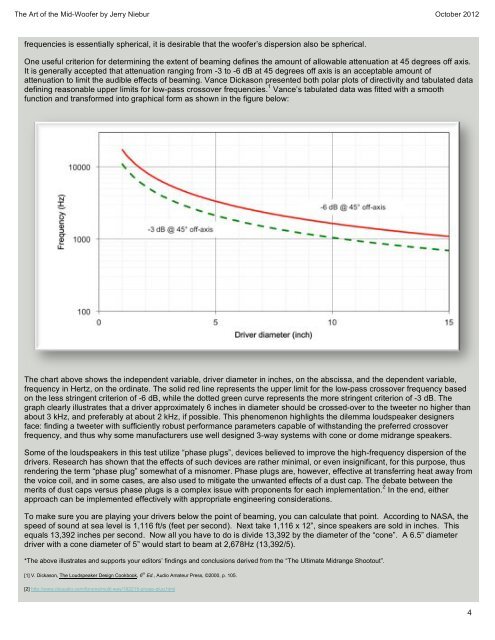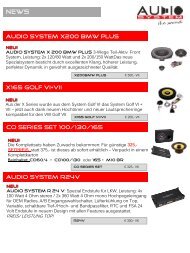You also want an ePaper? Increase the reach of your titles
YUMPU automatically turns print PDFs into web optimized ePapers that Google loves.
<strong>The</strong> <strong>Art</strong> <strong>of</strong> <strong>the</strong> <strong>Mid</strong>-Wo<strong>of</strong>er by Jerry Niebur October 2012<br />
frequencies is essentially spherical, it is desirable that <strong>the</strong> wo<strong>of</strong>er’s dispersion also be spherical.<br />
One useful criterion for determining <strong>the</strong> extent <strong>of</strong> beaming defines <strong>the</strong> amount <strong>of</strong> allowable attenuation at 45 degrees <strong>of</strong>f axis.<br />
It is generally accepted that attenuation ranging from -3 to -6 dB at 45 degrees <strong>of</strong>f axis is an acceptable amount <strong>of</strong><br />
attenuation to limit <strong>the</strong> audible effects <strong>of</strong> beaming. Vance Dickason presented both polar plots <strong>of</strong> directivity and tabulated data<br />
defining reasonable upper limits for low-pass crossover frequencies. 1 Vance’s tabulated data was fitted with a smooth<br />
function and transformed into graphical form as shown in <strong>the</strong> figure below:<br />
<strong>The</strong> chart above shows <strong>the</strong> independent variable, driver diameter in inches, on <strong>the</strong> abscissa, and <strong>the</strong> dependent variable,<br />
frequency in Hertz, on <strong>the</strong> ordinate. <strong>The</strong> solid red line represents <strong>the</strong> upper limit for <strong>the</strong> low-pass crossover frequency based<br />
on <strong>the</strong> less stringent criterion <strong>of</strong> -6 dB, while <strong>the</strong> dotted green curve represents <strong>the</strong> more stringent criterion <strong>of</strong> -3 dB. <strong>The</strong><br />
graph clearly illustrates that a driver approximately 6 inches in diameter should be crossed-over to <strong>the</strong> tweeter no higher than<br />
about 3 kHz, and preferably at about 2 kHz, if possible. This phenomenon highlights <strong>the</strong> dilemma loudspeaker designers<br />
face: finding a tweeter with sufficiently robust performance parameters capable <strong>of</strong> withstanding <strong>the</strong> preferred crossover<br />
frequency, and thus why some manufacturers use well designed 3-way systems with cone or dome midrange speakers.<br />
Some <strong>of</strong> <strong>the</strong> loudspeakers in this test utilize “phase plugs”, devices believed to improve <strong>the</strong> high-frequency dispersion <strong>of</strong> <strong>the</strong><br />
drivers. Research has shown that <strong>the</strong> effects <strong>of</strong> such devices are ra<strong>the</strong>r minimal, or even insignificant, for this purpose, thus<br />
rendering <strong>the</strong> term “phase plug” somewhat <strong>of</strong> a misnomer. Phase plugs are, however, effective at transferring heat away from<br />
<strong>the</strong> voice coil, and in some cases, are also used to mitigate <strong>the</strong> unwanted effects <strong>of</strong> a dust cap. <strong>The</strong> debate between <strong>the</strong><br />
merits <strong>of</strong> dust caps versus phase plugs is a complex issue with proponents for each implementation. 2 In <strong>the</strong> end, ei<strong>the</strong>r<br />
approach can be implemented effectively with appropriate engineering considerations.<br />
To make sure you are playing your drivers below <strong>the</strong> point <strong>of</strong> beaming, you can calculate that point. According to NASA, <strong>the</strong><br />
speed <strong>of</strong> sound at sea level is 1,116 ft/s (feet per second). Next take 1,116 x 12”, since speakers are sold in inches. This<br />
equals 13,392 inches per second. Now all you have to do is divide 13,392 by <strong>the</strong> diameter <strong>of</strong> <strong>the</strong> “cone”. A 6.5” diameter<br />
driver with a cone diameter <strong>of</strong> 5” would start to beam at 2,678Hz (13,392/5).<br />
*<strong>The</strong> above illustrates and supports your editors’ findings and conclusions derived from <strong>the</strong> “<strong>The</strong> Ultimate <strong>Mid</strong>range Shootout”.<br />
[1] V. Dickason, <strong>The</strong> Loudspeaker Design Cookbook, 6 th Ed., Audio Amateur Press, ©2000, p. 105.<br />
[2] http://www.diyaudio.com/forums/multi-way/192215-phase-plug.html<br />
4





